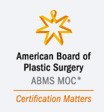

Like people, breasts come in all shapes and sizes. For those who are dissatisfied with their breasts or whose breasts have been affected by injury or disease, aesthetic breast surgery offers an amazing opportunity to reshape the body. As unique as the patients who seek them, these surgeries are highly customized procedures that must take into account factors as varied as the patient’s desires, their existing anatomy and the possibilities offered by technique and technology. Obtaining the best result truly requires a joint effort from both a board certified plastic surgeon and the patient.
Types of Breast Surgery
Breast surgeries are incredibly popular. In fact, breast augmentation was the top cosmetic surgical procedure in 2014, a rank it has held since 2006, according to the American Society of Plastic Surgeons’ “2014 Plastic Surgery Statistics Report.” A medical procedure combining art and science, this surgery involves placing implants to adjust the volume or contour of the breasts to create the desired size, shape and balance.
Augmentations were not the only requested breast surgery. Cosmetic surgeons also performed more than 92,000 mastopexies. Often referred to as breast lifts, these procedures boost and reshape sagging breasts and can be done alone or combined with an augmentation. In addition, in 2014 roughly 41,000 women and 26,000 men underwent breast reductions for aesthetic reasons.
Some patients spend months contemplating breast enhancement surgery; others ponder the decision to undergo surgery for years before scheduling a consultation with a plastic surgeon. Ultimately, the length of time spent making the decision is variable and a patient’s level of satisfaction with their results is rarely tied to the duration of their deliberations. Realistic expectations are far more important, and those are best cultivated during the initial consultation.
The Initial Consultation
If you decide to undergo breast surgery, what should you expect during the initial consultation? Be ready to discuss exactly what you want to achieve in a frank and open manner, including the things that bother you about your breasts and the improvements that you hope to see. In addition, you should be prepared to provide information regarding your general health. Whether you are seeking an augmentation, lift or reduction, the procedure is a surgery, and verification that nothing in your health history precludes you from undergoing it is vital. To establish that your reasons for pursuing the procedure are emotionally healthy, you may also be asked about your motivations. Once the doctor understands your goals, they will educate you about your options. Patients interested in augmentation will be shown implants while those considering a breast lift will have the chance to investigate various choices for internal support.
Once the initial questions have been answered, there will be a physical examination. With a nurse present, the plastic surgeon will inspect your breasts, studying your anatomy carefully to determine the best course for your surgery. In some cases, they will show you areas of interest or concern in a mirror to help you understand what is possible. Many plastic surgeons draw pictures to assist their patients in visualizing the procedure. Before the consultation ends, they will walk you through the plan for your surgery from any pre-op requirements to the post-op care and recovery period needed.
Some patients leave the consultation ready to schedule their surgery immediately; others take time to decide on their course. Either plan is perfectly acceptable.
What to Expect During Breast Surgery
While the specific details of each procedure vary depending on the patient, their goals and their anatomy, certain basic steps are part of any breast surgery. These include:
- Administering anesthesia. The possibilities include general anesthesia and intravenous sedation.
- Making the incision. The location of any incisions depends on the patient’s desires, the procedure chosen and the surgeon’s preference.
- Placing Implants. In the case of an augmentation, this entails placing the selected implants in pockets created either immediately behind the breast tissue or beneath the chest muscles.
- Reshaping the breasts. For breast lifts, this involves improving the breasts’ contours and firmness by lifting and reshaping tissue, repositioning the areola, and removing excess skin. With reduction surgeries, the nipple is repositioned, fat and glandular tissue is removed, the remaining tissue is reshaped, and the skin is tightened.
- Closing the incision. After the breast has been reshaped and/or the implant placed, the skin is closed with a combination of additional sutures, surgical tape and skin adhesives.
Incisions and Implants
Where will incisions be made? The answer varies. Each type of breast surgery can be performed through multiple incision sites. For augmentation surgeries, incisions can be made at the areola, beneath the breast or at the armpit (Dr. Salemy does not perform the procedure through an armpit incision, and he will review the pros and cons of each approach at your consultation). Breast lifts require incisions around the areola; around the areola and down to the breast crease; or around the areola, down the breast crease and along the crease beneath the breast. With breast reductions, the incisions may be around the areola; around the areola and down to the breast crease in a pattern reminiscent of a keyhole; or around the areola, down the breast to the crease that runs beneath it and horizontally across that crease. Regardless of the type of surgery, the placement of the incision does not impact recovery time.
Unlike other procedures, the use of implant devices adds another layer of complexity. When the surgical plan includes enhancing the size of the breasts, patients will need to select implants. Most people have heard of saline implants, which are filled with sterile salt water, and silicone implants, which are filled with a silicone gel, but other types of implants are available. Sometimes referred to as gummy bear implants, form-stable implants retain their shape even if their shell is broken, round implants appear fuller, smooth implants offer a soft feel and more natural movement, and textured implants are designed to bond with tissue, reinforcing their placement.
The Possibilities
Plastic surgery offers an effective way to adjust the size, shape and appearance of the breasts, and seeking out an experienced surgeon is crucial for patients who want the best possible results. However, patients must be aware that their results are not entirely reliant on the doctor’s skills. The patient’s health and anatomy also impact the success of the surgery. The best candidates for enhancement, lift or reduction surgery are nonsmokers who maintain a stable weight, are generally healthy and have reasonable expectations. Health issues and previous surgeries do not necessarily disqualify someone from having breast surgery, but they can complicate the procedure and may affect the results.
Anatomy
A patient’s existing anatomy also plays a role in determining the results that are attainable. For example, a patient with a small bust line may be urged to avoid huge jumps in breast size. Instead, the doctor might suggest an implant that creates breasts that are a better match for her overall proportions. Likewise, the anatomy of a patient who has had one or more previous surgeries can be more challenging to work with, so achieving the desired results can be more difficult.
Patients with better anatomy and reasonable expectations will typically enjoy better results, but the public is largely unaware that anatomy is a factor. Why is there so little discussion regarding the role that anatomy plays in the outcome of breast surgeries? It may be because the subject is complicated, so it is hard to discuss in generalities. This is part of the reason that a consultation with a plastic surgeon can be so valuable. It provides an ideal opportunity for a patient to discuss their goals and learn what is reasonable based on their unique situation.















